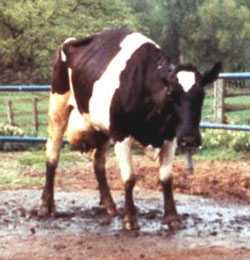About BSE

Cattle such as the one pictured here, which are affected by BSE experience progressive degeneration of the nervous system.
BSE (bovine spongiform encephalopathy) is a progressive neurological disorder of cattle that results from infection by an unusual transmissible agent called a prion. The nature of the transmissible agent is not well understood. Currently, the most accepted theory is that the agent is a modified form of a normal protein known as prion protein. For reasons that are not yet understood, the normal prion protein changes into a pathogenic (harmful) form that then damages the central nervous system of cattle.
Research indicates that the first probable infections of BSE in cows occurred during the 1970’s with two cases of BSE being identified in 1986. BSE possibly originated as a result of feeding cattle meat-and-bone meal that contained BSE-infected products from a spontaneously occurring case of BSE or scrapie-infected sheep products. Scrapie is a prion disease of sheep. There is strong evidence and general agreement that the outbreak was then amplified and spread throughout the United Kingdom cattle industry by feeding rendered, prion-infected, bovine meat-and-bone meal to young calves.
The BSE epizootic in the United Kingdom peaked in January 1993 at almost 1,000 new cases per week. Since then, the annual numbers of BSE cases in the United Kingdom have dropped sharply—
- 2 cases in 2015
- 11 cases in 2010
- 225 cases in 2005
- 1,443 cases in 2000
- 14,562 cases in 1995
Cumulatively, through the end of 2015, more than 184,500 cases of BSE had been confirmed in the United Kingdom alone in more than 35,000 herds. Regularly updated numbers of reported BSE cases, by country, are available on the website of the Office International Des Epizooties.
Strong epidemiologic and laboratory evidence exists for a causal association between a new human prion disease called variant Creutzfeldt-Jakob disease (vCJD) that was first reported from the United Kingdom in 1996 and the BSE outbreak in cattle. The interval between the most likely period for the initial extended exposure of the population to potentially BSE-contaminated food (1984-1986) and the onset of initial variant CJD cases (1994-1996) is consistent with known incubation periods for the human forms of prion disease.
- Page last reviewed: August 9, 2017
- Page last updated: August 9, 2017
- Content source:


 ShareCompartir
ShareCompartir